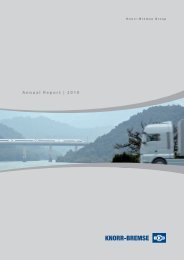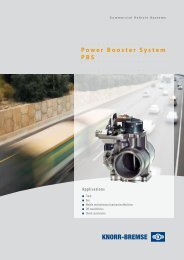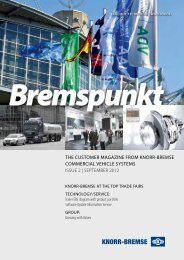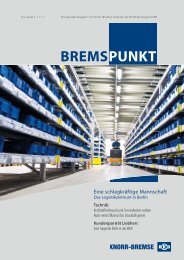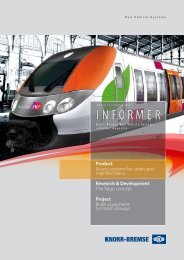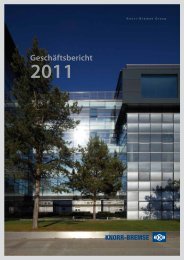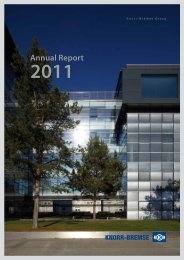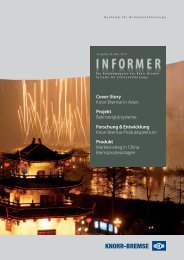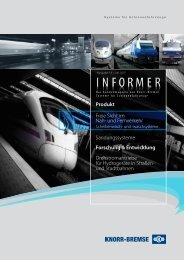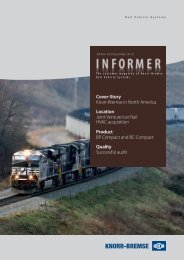Pneumatic Booster System PBS® Eliminate turbo ... - Knorr-Bremse
Pneumatic Booster System PBS® Eliminate turbo ... - Knorr-Bremse
Pneumatic Booster System PBS® Eliminate turbo ... - Knorr-Bremse
Create successful ePaper yourself
Turn your PDF publications into a flip-book with our unique Google optimized e-Paper software.
C o m m e r c i a l V e h i c l e S y s t e m s<br />
<strong>Pneumatic</strong> <strong>Booster</strong> <strong>System</strong> <strong>PBS®</strong><br />
<strong>Eliminate</strong> <strong>turbo</strong> lag<br />
and save fuel<br />
Applications<br />
Truck<br />
Bus<br />
Mobile and stationary construction machines<br />
Off-road vehicles<br />
Diesel locomotives
S h o c k A b s o r b e r<br />
Less fuel, more mileage<br />
Road test report: The magazine lastauto omnibus has road-tested a system from<br />
<strong>Knorr</strong>-<strong>Bremse</strong>s which claims to significantly reduce fuel consumption on trucks and<br />
buses. The result was astonishing.<br />
We still don't know all the details. What is<br />
clear, however, is that after almost twenty<br />
years of commercial vehicle emissions<br />
standards, Europe is now committed to<br />
introducing the first fuel economy standard.<br />
This could come as early as 2016, or<br />
at the latest by 2020. Rumour has it that<br />
cuts of between 14 and 20 percent in fuel<br />
consumption may be required. But we<br />
still have no clue as to what parameters<br />
will be measured, how they will be<br />
measured, and against what baseline the<br />
reduction will be calculated.<br />
Road tests with PBs<br />
<strong>System</strong>s Fuel consumption<br />
l/100 km<br />
On fuel consumption, commercial vehicle<br />
manufacturers have currently reached<br />
something of an impasse. They know<br />
exactly where further improvements<br />
could be made, but when it comes to<br />
implementing them they are dependent<br />
on legislation – and above all on their<br />
suppliers. On the legislative front, they<br />
would like to see an increase of about half<br />
a metre in maximum vehicle length<br />
regulations. This would offer benefits<br />
both for aerodynamics and for fuel<br />
economy. However, it is doubtful whether<br />
such legislation will be forthcoming. A<br />
much more realistic avenue is to make<br />
use of supplier-developed technologies,<br />
Fuel consumption<br />
difference<br />
Average rpm<br />
Test 1 without PBS/Eco 33,35 – 1.310/min<br />
Test 2 with PBS 32,71 –1,9 % 1.264/min<br />
Test 3 1) with PBS and Eco 31,74 –4,9 % 1.222/min<br />
Test 4 with PBS and Eco 31,06 –6,9 % 1.251/min<br />
1) Traffic disruption en route
1 The test vehicle: a 430 hp MAN TGA semitrailer rig with automated transmission.<br />
such as <strong>Knorr</strong>-<strong>Bremse</strong>'s <strong>Pneumatic</strong><br />
<strong>Booster</strong> <strong>System</strong> (PBS).<br />
"PBS will be on the road by late 2012,"<br />
promises <strong>Knorr</strong>-<strong>Bremse</strong> test engineer<br />
Daniel Geis-Esser. Since <strong>Knorr</strong>-<strong>Bremse</strong><br />
manufactures air brake systems, it is<br />
perhaps not surprising that PBS too is a<br />
compressed air-based system. This is<br />
hinted at by the "P" in the initials, which<br />
stands for "pneumatic". In a nutshell, the<br />
PBS system has the ambitious aim of<br />
eliminating <strong>turbo</strong> lag – by injecting<br />
compressed air into the engine's intake<br />
manifold. A large <strong>turbo</strong>diesel engine<br />
normally takes three or four seconds or<br />
even longer between the driver stepping<br />
on the accelerator and producing its<br />
maximum torque. With PBS however, air<br />
from the compressed air tanks eliminates<br />
this performance lag and ensures faster<br />
throttle response. As a result, the acceleration<br />
shift points can be lowered, with a<br />
positive impact on fuel consumption.<br />
Depending on application, <strong>Knorr</strong>-<strong>Bremse</strong><br />
says the system can achieve between<br />
three and five percent fuel savings.<br />
The design and operation of PBS are<br />
delightfully simple. The system consists of<br />
a cylindrical pipe with a centrally located<br />
throttle valve, two pressure sensors, two<br />
diaphragm valves of different sizes and<br />
software whose job is to decide whether<br />
to inject compressed air and if so how<br />
much and for how long. Whether compressed<br />
air injection is required will<br />
depend mainly on the driver's throttle<br />
commands. The quantity of air supplied<br />
can range from 40 to 90 litres. The air is<br />
injected into the intake manifold at a<br />
pressure of twelve bar, for a period of<br />
between 0.8 and 1.6 seconds.<br />
When PBS is activated, a number of things<br />
happen: the PBS throttle valve closes, air<br />
is injected audibly into the manifold, the<br />
engine rapidly builds up the necessary<br />
torque to match the throttle command<br />
and the rev needle flicks up by 100-200<br />
rpm. Simultaneously, the <strong>turbo</strong>charger<br />
comes up to speed much more quickly<br />
than it would without PBS, since the<br />
increase in torque is translated directly<br />
into a corresponding increase in exhaust<br />
gas energy. The digital test instrument
2 Precise fuel consumption measurement: the 30-litre test tank was weighed before and after<br />
each lap, then refilled.<br />
display shows a swift surge in <strong>turbo</strong>charger<br />
speed from 50,000 to 100,000 rpm.<br />
As soon as the pressure on either side of<br />
the throttle valve has equalised, the valve<br />
opens again and normal operation is<br />
resumed.<br />
On the 27-kilometre test route, PBS on its<br />
own (without ECO mode) already brought<br />
a 1.9 percent improvement in fuel<br />
consumption (see table, test 2). The tests<br />
were carried out with an almost fully<br />
laden semitrailer, drawn by a 316 kW<br />
(430 hp) MAN tractor unit with automated<br />
transmission. The test rig, sporting a<br />
complete array of test equipment,<br />
completed five laps of the relatively<br />
low-traffic test route, the first one being a<br />
familiarisation lap. As the tests showed,<br />
the full potential of PBS only reveals itself<br />
when it is combined with a transmission<br />
controller with selectable Eco mode.<br />
Because PBS causes the engine to respond<br />
powerfully to all throttle commands, even<br />
at very low engine speeds, this can be<br />
exploited to lower the transmission's shift<br />
points. When accelerating, the automated<br />
transmission will then shift up at, say,<br />
1300 rather than 1500 rpm. When the<br />
engine speed drops back just below<br />
With PBS (blue), a <strong>turbo</strong>diesel<br />
engine develops boost pressure<br />
and torque much faster than<br />
without (orange).
Two supplementary air tanks, providing 80 litres of additional compressed<br />
air capacity, were fitted behind the side panels.<br />
1000 rpm following the shift, PBS is<br />
activated and rpm climbs quickly and<br />
vigorously again. The same principle<br />
applies when coasting in hilly terrain. A<br />
slight dip of the accelerator, resulting in<br />
PBS activation, may be sufficient to<br />
overcome the increased resistance when<br />
ascending a slight uphill grade. Without<br />
PBS, the transmission would shift down at<br />
this point. Positive effects of PBS noted in<br />
the test were: an increased amount of<br />
driving time spent in top gear, a substantial<br />
rpm reduction and, finally, a hefty 6.9<br />
percent reduction in fuel consumption on<br />
test lap 4. Test lap 3 had already recorded<br />
a 4.8 percent saving, but had to be repeated<br />
due to traffic disruption en route.<br />
A 6.9 percent saving, or fuel consumption<br />
of 31.06 litres/100 km instead of 33.35 litres,<br />
actually goes well beyond the manu facturer's<br />
own claims. Similar measurements<br />
conducted earlier by <strong>Knorr</strong>-<strong>Bremse</strong><br />
indicated a savings potential in the order<br />
of 4.3 percent. Obviously, the actual<br />
savings achieved depend very much on<br />
the route being driven. Routes with<br />
relatively frequent starting from rest,<br />
frequent acceleration and hilly topography,<br />
like the test route used by lastauto<br />
omnibus, result in higher savings. But<br />
even in long-haul operation, PBS should<br />
still be capable of achieving savings of<br />
two percent, partly because a lower<br />
final-drive ratio can be used. That said,<br />
clearly the biggest benefits of PBS will be<br />
in short-radius distribution and local<br />
public transport, where the system can<br />
be used to support engine downsizing,<br />
i.e. a smaller engine with PBS can replace<br />
a larger engine without this feature. PBS<br />
will probably make its debut in a bus.<br />
So what are the downsides? Well, the<br />
system increases compressed air consumption<br />
by between 20 and 30 percent,<br />
which may require a larger air compressor<br />
and larger air tanks. On our test rig though,<br />
the standard-specification (360 cc)<br />
single-cylinder compressor proved to be<br />
sufficient, although supplementary tanks<br />
were fitted to increase air capacity by<br />
80 litres. The big plus point is the relatively<br />
modest price (max. 600 euros).<br />
The PBS system is based on a pipe, a throttle valve,<br />
two temperature sensors, two diaphragm valves, a<br />
processor – and lots of development work.
C o m m e r c i a l V e h i c l e S y s t e m s<br />
Head Office<br />
<strong>Knorr</strong>-<strong>Bremse</strong> systeme für<br />
Nutzfahrzeuge Gmbh<br />
Moosacher Strasse 80<br />
80809 Munich<br />
Germany<br />
Tel: +49 89 3547-0<br />
Fax: +49 89 3547-2767<br />
www.knorr-bremseCVS.com<br />
europe – africa<br />
Austria<br />
<strong>Knorr</strong>-<strong>Bremse</strong> Gmbh<br />
systeme für Nutzfahrzeuge<br />
Mödling<br />
Tel: +43 2236 409-2436<br />
Fax: +43 2236 409-2434<br />
Belgium<br />
<strong>Knorr</strong>-<strong>Bremse</strong> Benelux B.V.B.a.<br />
Heist-op-den-Berg<br />
Tel: +32 1525 7900<br />
Fax: +32 1524 9240<br />
Czech Republic<br />
<strong>Knorr</strong>-<strong>Bremse</strong> systémy pro<br />
uzitková vozidla, CR, s.r.o.<br />
Straz nad Nisou<br />
Tel: +420 482 363-611<br />
Fax: +420 482 363-711<br />
France<br />
<strong>Knorr</strong>-<strong>Bremse</strong><br />
systèmes pour Véhicules<br />
Utilitaires France<br />
Lisieux Cedex<br />
Tel: +33 2 3132 1200<br />
Fax: +33 2 3132 1303<br />
Germany<br />
hasse & wrede Gmbh<br />
Berlin<br />
Tel: +49 30 9392-3101<br />
Fax: +49 30 7009-0811<br />
Germany<br />
<strong>Knorr</strong>-<strong>Bremse</strong> systeme für<br />
Nutzfahrzeuge Gmbh<br />
Berlin<br />
Tel: +49 180 223-7637<br />
Fax: +49 30 9392-3426<br />
Hungary<br />
<strong>Knorr</strong>-<strong>Bremse</strong><br />
Fékrendszerek Kft.<br />
Kecskemét<br />
Tel: +36 76 511 100<br />
Fax: +36 76 481 100<br />
Italy<br />
<strong>Knorr</strong>-<strong>Bremse</strong><br />
sistemi per autoveicoli<br />
Commerciali s.p.a.<br />
Arcore<br />
Tel: +39 039 6075-1<br />
Fax: +39 039 6075-435<br />
Netherlands<br />
<strong>Knorr</strong>-<strong>Bremse</strong> Benelux B.V.B.a.<br />
Mydrecht<br />
Tel: +31 297 239-330<br />
Fax: +31 297 239-339<br />
Poland<br />
<strong>Knorr</strong>-<strong>Bremse</strong> Polska sfN sp. z o.o.<br />
Warsaw<br />
Tel: +48 22 887-3870<br />
Fax: +48 22 531-4170<br />
Russia<br />
<strong>Knorr</strong>-<strong>Bremse</strong> RUs<br />
Nizhniy Novgorod<br />
Tel: +7 8312 57-6661<br />
Fax: +7 8312 57-6791<br />
Russia<br />
<strong>Knorr</strong>-<strong>Bremse</strong><br />
systeme für Nutzfahrzeuge Gmbh<br />
Moscow<br />
Tel: +7 495 234-4995<br />
Fax: +7 495 234-4996<br />
South Africa<br />
<strong>Knorr</strong>-<strong>Bremse</strong> s.a. Pty. Ltd.<br />
Kempton Park<br />
Tel: +27 11 961-7800<br />
Fax: +27 11 975-8249<br />
Spain<br />
Bost ibérica, s.L.<br />
Irun (Guipuzcoa)<br />
Tel: +34 902 100-569<br />
Fax: +34 943 614-063<br />
Sweden<br />
<strong>Knorr</strong>-<strong>Bremse</strong><br />
system for tunga Fordon aB<br />
Lund<br />
Tel: +46 46 440 0105<br />
Fax: +46 46 148971<br />
Switzerland<br />
<strong>Knorr</strong>-<strong>Bremse</strong><br />
systeme für Nutzfahrzeuge Gmbh<br />
Bassersdorf<br />
Tel: +41 44 888 77-55<br />
Fax: +41 44 888 77-50<br />
Turkey<br />
<strong>Knorr</strong>-<strong>Bremse</strong><br />
ticari araç Fren sistemleri tic. Ltd. sti.<br />
Findikli - Istanbul<br />
Tel: +90 212 293-4742<br />
Fax: +90 212 293-4743<br />
United Kingdom<br />
<strong>Knorr</strong>-<strong>Bremse</strong><br />
systems for Commercial Vehicles Ltd.<br />
Bristol<br />
Tel: +44 117 9846-100<br />
Fax: +44 117 9846-101<br />
america<br />
Brazil<br />
<strong>Knorr</strong>-<strong>Bremse</strong><br />
sistemas para Veículos<br />
Comerciais Brasil Ltda.<br />
São Paulo<br />
Tel: +55 11 5681 1104<br />
Fax: +55 11 5686 3905<br />
USA<br />
Bendix Commercial Vehicle<br />
systems LLC<br />
Elyria, OH<br />
Tel: +1 440 329-9100<br />
Fax: +1 440 329-9105<br />
asia – australia<br />
Australia<br />
<strong>Knorr</strong>-<strong>Bremse</strong><br />
australia Pty. Ltd.<br />
Granville NSW<br />
Tel: +61 2 8863-6500<br />
Fax: +61 2 8863-6510<br />
China<br />
<strong>Knorr</strong>-<strong>Bremse</strong><br />
Brake equipment (shanghai) Co. Ltd.<br />
Shanghai<br />
Tel: +86 21 3858-5800<br />
Fax: +86 21 3858-5900<br />
China<br />
<strong>Knorr</strong>-<strong>Bremse</strong><br />
asia Pacific (holding) Limited<br />
Commercial Vehicle systems division<br />
Hong Kong<br />
Tel: +852 3657-9800<br />
Fax: +852 3657-9901<br />
India<br />
<strong>Knorr</strong>-<strong>Bremse</strong><br />
systems for Commercial Vehicles<br />
india Private Ltd.<br />
Pune<br />
Tel: +91 20 6674-6800<br />
Fax: +91 20 6674-6899<br />
Japan<br />
<strong>Knorr</strong>-<strong>Bremse</strong><br />
Commercial Vehicle systems<br />
Japan Ltd.<br />
Saitama<br />
Tel: +81 49 273-9155<br />
Fax: +81 49 282-8601<br />
Korea<br />
<strong>Knorr</strong>-<strong>Bremse</strong><br />
Korea Ltd. truck Brake division<br />
Seoul<br />
Tel: +82 2 2273-1182<br />
Fax: +82 2 2273-1184<br />
This document is subject to alteration without notice and therefore a printed copy may not be the latest revision. Please check our website www.knorr-bremseCVS.com for the latest update or contact your local <strong>Knorr</strong>-<strong>Bremse</strong> representative.<br />
The figurative mark “K” and the trademarks KNORR and KNORR-BREMSE are registered in the name of <strong>Knorr</strong>-<strong>Bremse</strong> AG. Additional terms and conditions apply; please refer to our website knorr-bremseCVS.com under the “Documentation”<br />
tab. Note: If service work is carried out on a vehicle as a result of information taken from this document, it is the responsibility of the workshop to ensure the vehicle is fully tested and in full functional order before the vehicle is returned into<br />
service. <strong>Knorr</strong>-<strong>Bremse</strong> accepts no liability for problems caused as a result of appropriate tests not being carried out. Copyright 2010 © <strong>Knorr</strong>-<strong>Bremse</strong> AG - all rights reserved, including industrial property rights applications. <strong>Knorr</strong>-<strong>Bremse</strong><br />
AG retains any power of disposal, such as for copying and transferring. Released11/2011<br />
<strong>Knorr</strong>-<strong>Bremse</strong> <strong>System</strong>e für Nutzfahrzeuge GmbH . Georg-<strong>Knorr</strong>-Strasse 4 . D-12681 Berlin . Deutschland . Tel: +49 180 223-7637 . Fax: +49 30 93927-3426 . www.knorr-bremseCVS.com


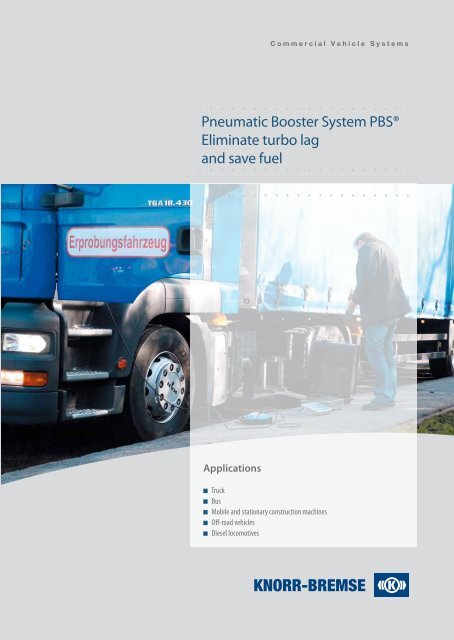
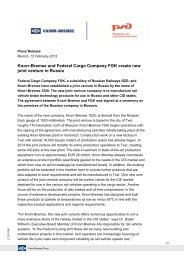
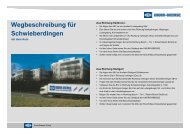
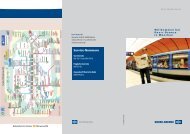
![Geschäftsbericht 2010 [PDF, 23 MB] - Knorr-Bremse](https://img.yumpu.com/9723397/1/185x260/geschaftsbericht-2010-pdf-23-mb-knorr-bremse.jpg?quality=85)

